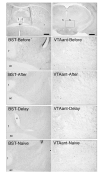FOS expression induced by an ethanol-paired conditioned stimulus
- PMID: 17531293
- PMCID: PMC2025694
- DOI: 10.1016/j.pbb.2007.04.017
FOS expression induced by an ethanol-paired conditioned stimulus
Abstract
To identify brain areas involved in ethanol-induced Pavlovian conditioning, brains of male DBA/2J mice were immunohistochemically analyzed for FOS expression after exposure to a conditioned stimulus (CS) previously paired with ethanol (2 g/kg) in two experiments. Mice were trained with a procedure that normally produces place preference (Before: ethanol before the CS) or one that normally produces place aversion (After: ethanol after the CS). Control groups received unpaired ethanol injections in the home cage (Delay) or saline only (Naïve). On the test day, mice were exposed to the 5-min CS 90 min before sacrifice. Before groups showed a conditioned increase in activity, whereas the After group showed a conditioned decrease in activity. FOS expression after a drug-free CS exposure was significantly higher in Before-group mice than in control mice in the bed nucleus of the stria terminalis (Experiment 1) and anterior ventral tegmental area (Experiments 1-2). Conditioned FOS responses were also seen in areas of the extended amygdala and hippocampus (Experiment 2). However, no conditioned FOS changes were seen in any brain area examined in After-group mice. Overall, these data suggest an important role for the mesolimbic dopamine pathway, extended amygdala and hippocampus in ethanol-induced conditioning.
Figures





Similar articles
-
Conditioned activation induced by ethanol: role in sensitization and conditioned place preference.Pharmacol Biochem Behav. 1992 Sep;43(1):307-13. doi: 10.1016/0091-3057(92)90673-4. Pharmacol Biochem Behav. 1992. PMID: 1409816
-
Rapid induction of Pavlovian approach to an ethanol-paired visual cue in mice.Psychopharmacology (Berl). 2007 Jun;192(2):231-41. doi: 10.1007/s00213-007-0704-4. Epub 2007 Jan 30. Psychopharmacology (Berl). 2007. PMID: 17265074
-
Ethanol-induced expression of c-Fos differentiates the FAST and SLOW selected lines of mice.Alcohol Clin Exp Res. 1999 Jan;23(1):87-95. Alcohol Clin Exp Res. 1999. PMID: 10029207
-
Ethanol-induced conditioned place aversion in mice.Behav Pharmacol. 2000 Nov;11(7-8):591-602. doi: 10.1097/00008877-200011000-00006. Behav Pharmacol. 2000. PMID: 11198130
-
Apparatus bias and place conditioning with ethanol in mice.Psychopharmacology (Berl). 2003 Dec;170(4):409-22. doi: 10.1007/s00213-003-1559-y. Epub 2003 Oct 30. Psychopharmacology (Berl). 2003. PMID: 12955296 Review.
Cited by
-
Ethanol effects on N-methyl-D-aspartate receptors in the bed nucleus of the stria terminalis.Cold Spring Harb Perspect Med. 2013 Apr 1;3(4):a012161. doi: 10.1101/cshperspect.a012161. Cold Spring Harb Perspect Med. 2013. PMID: 23426579 Free PMC article. Review.
-
Ethanol-induced conditioned place preference and aversion differentially alter plasticity in the bed nucleus of stria terminalis.Neuropsychopharmacology. 2019 Oct;44(11):1843-1854. doi: 10.1038/s41386-019-0349-0. Epub 2019 Feb 22. Neuropsychopharmacology. 2019. PMID: 30795004 Free PMC article.
-
Roles of the nucleus accumbens and amygdala in the acquisition and expression of ethanol-conditioned behavior in mice.J Neurosci. 2008 Jan 30;28(5):1076-84. doi: 10.1523/JNEUROSCI.4520-07.2008. J Neurosci. 2008. PMID: 18234886 Free PMC article.
-
Genetically correlated effects of selective breeding for high and low methamphetamine consumption.Genes Brain Behav. 2009 Nov;8(8):758-71. doi: 10.1111/j.1601-183X.2009.00522.x. Epub 2009 Jul 21. Genes Brain Behav. 2009. PMID: 19689456 Free PMC article.
-
CRF modulation of central monoaminergic function: Implications for sex differences in alcohol drinking and anxiety.Alcohol. 2018 Nov;72:33-47. doi: 10.1016/j.alcohol.2018.01.007. Epub 2018 Feb 2. Alcohol. 2018. PMID: 30217435 Free PMC article. Review.
References
-
- Bachtell RK, Tsivkovskaia NO, Ryabinin AE. Strain differences in urocortin expression in the Edinger-Westphal nucleus and its relation to alcohol-induced hypothermia. Neuroscience. 2002;113:421–434. - PubMed
-
- Bachtell RK, Wang Y-M, Freeman P, Risinger FO, Ryabinin AE. Alcohol drinking produces brain region-selective changes in expression of inducible transcription factors. Brain Research. 1999;847:157–165. - PubMed
-
- Bachtell RK, Weitemier AZ, Ryabinin AE. Lesions of the Edinger-Westphal nucleus in C57BL/6J mice disrupt ethanol-induced hypothermia and ethanol consumption. Eur J Neurosci. 2004;20:1613–1623. - PubMed
-
- Balleine BW, Killcross S. Parallel incentive processing: an integrated view of amygdala function. Trends Neurosci. 2006;29:272–279. - PubMed
Publication types
MeSH terms
Substances
Grants and funding
LinkOut - more resources
Full Text Sources

